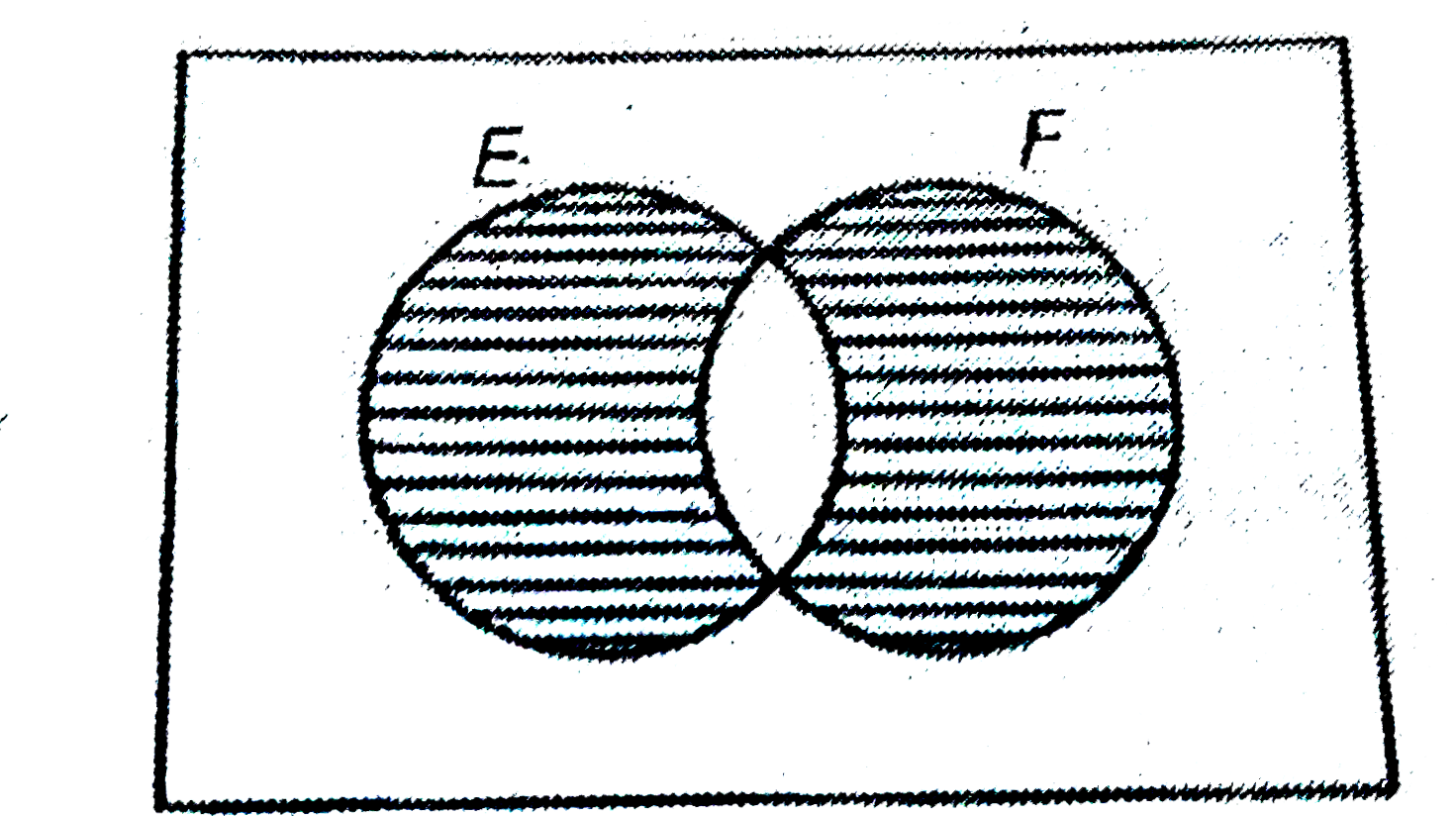Let EandF be tow independent events. The probability that exactly one of them occurs is 11/25 and the probability if none of them occurring is 2/25. If P(T) deontes the probability of occurrence of the event T, then P(E)=45,P(F)=35 P(E)=15,P(F)=25 P(E)=25,P(F)=15 P(E)=35,P(F)=45
P(E)=45,P(F)=35
P(E)=15,P(F)=25
P(E)=25,P(F)=15
P(E)=35,P(F)=45
The correct Answer is:A, B

P(E∪F)−P(E∩F)=1125 ….(i)[i.e. only E or only F]

Neither of them occurs =225
⇒P(¯¯¯E∩¯¯¯F)=225 ...(ii)
From Eq. (i), P(E)+P(F)−2P(E∩F)=1125 .....(iii)
From Eq. (ii), (1−P(E))(1−P(F))=225
⇒1−P(E)−P(F)+P(E)⋅P(F)=225 ..(iv)
From Eqs. (iii) and (iv),
P(E)+P(F)=75and P(E)⋅P(F)=1225
∴P(E)⋅[75−P(E)]=1225
⇒(P(E))2−75P(E)+1225=0
⇒[P(E)−35][P(E)−45]=0
∴P(E)=35or45⇒P(F)=45 or35
Topper's Solved these Questions
- PROBABILITYBOOK - IIT JEE PREVIOUS YEARCHAPTER - PROBABILITYEXERCISE - TOPIC 3 INDEPENDENT AND CONDITIONAL PROBABILITY OBJECTIVE QUESTION II (FILL IN THE BLANKS )
5 Videos
- PROBABILITYBOOK - IIT JEE PREVIOUS YEARCHAPTER - PROBABILITYEXERCISE - TOPIC 3 INDEPENDENT AND CONDITIONAL PROBABILITY OBJECTIVE QUESTION II (ANALYTICAL AND DESCRIPTIVE QUESTIONS )
11 Videos
- PROBABILITYBOOK - IIT JEE PREVIOUS YEARCHAPTER - PROBABILITYEXERCISE - TOPIC 3 INDEPENDENT AND CONDITIONAL PROBABILITY OBJECTIVE QUESTION I (ONLY ONE CORRECT OPTION)
20 Videos
- PERMUTATIONS AND COMBINATIONSBOOK - IIT JEE PREVIOUS YEARCHAPTER - PERMUTATIONS AND COMBINATIONSEXERCISE - Dearrangement and Number of Divisors (Fill in the Blank )
1 Video
- RELATIONS AND FUNCTIONS BOOK - IIT JEE PREVIOUS YEARCHAPTER - RELATIONS AND FUNCTIONS EXERCISE - All Questions
1 Video
Similar Questions
Let EandF be tow independent events. The probability that exactly one of them occurs is 11/25 and the probability if none of them occurring is 2/25. If P(T) deontes the probability of occurrence of the event T, then P(E)=45,P(F)=35 P(E)=15,P(F)=25 P(E)=25,P(F)=15 P(E)=35,P(F)=45
View SolutionLet A and B be two independent events. The probability of their simultaneous occurrence is 1/8 and the probability that neither occurs is 3/8. Find P(A)andP(B).
View Solution
Knowledge Check
Let E and F be two independent events. The probability that exactly one of them occurs is 11/25 and the probability of none of them occurring is 2/25. If P(T) denotes the probability of occurrence of the event T, then
AP(E)=45,P(F)=35BP(E)=15,P(F)=25CP(E)=25,P(F)=15DP(E)=35,P(F)=45Let E and F be two independent events. The probability that exactly one of them occurs is 11/25 and the probability of none of them occurring is 2/25. If P(T) denotes the probability of occurrence of the event T, then
AP(E)=45,P(E)=35BP(E)=15,P(F)=25CP(E)=25,P(F)=15DP(E)=35,P(F)=45If P (E) denotes probability of occurrence of event E, then :
AP(E)∈[−1,1]BP(E)∈(1,∞)CP(E)∈(0,1)DP(E)∈[0,1]
Let A and B be two events, the probability that at least one of them occurs is 45 and the probability that A and B occur simultaneously is 14, then P(A') + P(B') is equal to ____
View SolutionA and B are two events such that the probability that both A and B occur is 16 and the probability that at 2 least one of them occurs is 23• The probability of the occurrence of A=___ if P(A)=2P(B).
View SolutionLet E and F be two independent events. The probability that both E and F happen is 112 and the probability that neither E nor F happens is 12, then a value of P(E)P(F) is
View SolutionE and F be two independent events such that P(E) < P(F). The probability that both E and F happen is 1/15 and the probability that neither E nor F happen is 8/15. Then P(E) = ____
View SolutionLet E and F be two independent events such that P (E) > P(F). The probability that both E and F happened is 112 and the probability that neither E nor F happens is 12, then
View Solution